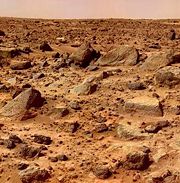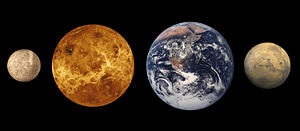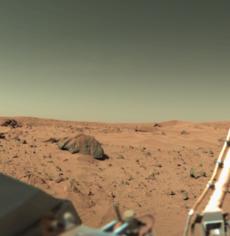
- Moons: 2
- Mass: 11% of Earth
- Diameter: 4217 miles
- Year: 1.9 Earth years
- Day: 24.6 hours
- Temperature: -190 to +60 degrees F
- Distance from the Sun: 4th planet from the sun, 142 million miles
What is Mars like?
Mars is the 4th planet from the sun. It is a terrestrial planet which means it has a hard rocky surface that you could walk on. Mars' surface is dry and much of it is covered with a reddish dust and rocks. To us on Earth Mars appears to be red.
 Mars has some of the most impressive natural geographical structures in the solar system. Olymus Mons, a now dormant volcano, is the highest mountain in the solar system. It is 3 times as high as Mount Everest and towers 16 miles above the Martian surface. Another major geographical structure of Mars is the great canyon, Valles Marineris. This canyon is the biggest in the solar system. It is 4 miles deep in places and stretches for thousands of miles.
Mars has some of the most impressive natural geographical structures in the solar system. Olymus Mons, a now dormant volcano, is the highest mountain in the solar system. It is 3 times as high as Mount Everest and towers 16 miles above the Martian surface. Another major geographical structure of Mars is the great canyon, Valles Marineris. This canyon is the biggest in the solar system. It is 4 miles deep in places and stretches for thousands of miles.
Mars often has huge dust storms with high speed winds. These dust storms are powered by the sun and can grow to enormous proportions sending dust miles into the atmosphere and covering much of the planet. Some storms are so big they can be seen by amateur astronomers on Earth.
Mars is the 4th planet from the sun. It is a terrestrial planet which means it has a hard rocky surface that you could walk on. Mars' surface is dry and much of it is covered with a reddish dust and rocks. To us on Earth Mars appears to be red.
 Mars has some of the most impressive natural geographical structures in the solar system. Olymus Mons, a now dormant volcano, is the highest mountain in the solar system. It is 3 times as high as Mount Everest and towers 16 miles above the Martian surface. Another major geographical structure of Mars is the great canyon, Valles Marineris. This canyon is the biggest in the solar system. It is 4 miles deep in places and stretches for thousands of miles.
Mars has some of the most impressive natural geographical structures in the solar system. Olymus Mons, a now dormant volcano, is the highest mountain in the solar system. It is 3 times as high as Mount Everest and towers 16 miles above the Martian surface. Another major geographical structure of Mars is the great canyon, Valles Marineris. This canyon is the biggest in the solar system. It is 4 miles deep in places and stretches for thousands of miles. Mars often has huge dust storms with high speed winds. These dust storms are powered by the sun and can grow to enormous proportions sending dust miles into the atmosphere and covering much of the planet. Some storms are so big they can be seen by amateur astronomers on Earth.

From right to left: Mecury, Venus, Earth, Mars.
How does Mars compare to Earth?
In many ways, Mars is very similar to Earth. Mars' year and day are very similar to Earth compared to other planets. Mars' is a terrestrial planet like Earth. Mars' is smaller than Earth both in diameter and in mass.
Unlike Earth, Mars has a very thin atmosphere made up mostly of carbon dioxide. As a result, it is much colder on Mars (average of -70 degrees F).
There is evidence that open water in liquid form once existed on the surface of Mars like Earth. Perhaps there was even life on Mars billions of years ago.

How do we know about Mars?
Mars is one of the easiest planets to study from Earth. It is fairly close and, since it is further from the sun than us, it is easy to view in the night sky. The Mariner 4 spacecraft was the first to bring us close up pictures of Mars in 1965. Since then several space probes have visited Mars. The Viking 1, Viking 2, and Pathfinder landers, landed on the surface of Mars and sent us back pictures of the surface and analyzed the Martian soil. Mars will likely be the first planet that a human step foot on. Many people believe it could happen by the year 2020.
